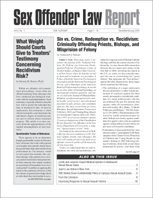Flaws in Eyewitness Identification, Part III
Author: Roslyn Myers, Ph.D., J.D..
Source: Volume 19, Number 04, June/July 2018 , pp.51-53(3)

< previous article |next article > |return to table of contents
Abstract:
This is the third in a series examining flaws in eyewitness identification. In the first two parts, the author examined two basic types of factors that influence the way a witness encodes or processes a memory: “estimator variables,” which are beyond the control of the criminal justice system, may be particular to the individual witness, such as the stress level and ability for the individual to remain calm, or may be coincident to the event, such as low lighting or poor weather; and a second set of variables, those practices and procedures for eyewitness identification used by law enforcement, or “system variables.” It is the latter groups that offer the best opportunity to improve the way eyewitnesses present their memories for an event of an offender. In this article, the author focuses on the challenges of cross-race identification and the related tendency of human memory to operate categorically.Keywords: Influence of Embedded Categories on Memory; Cross-Race Evidence
Affiliations:
1: John Jay College of Criminal Justice.